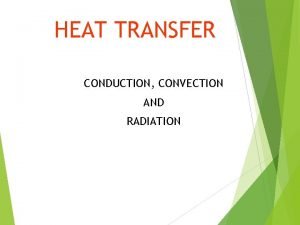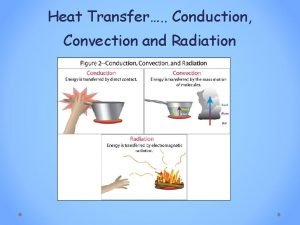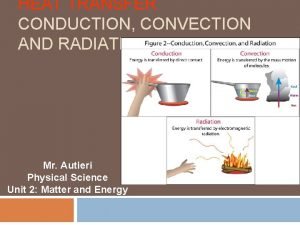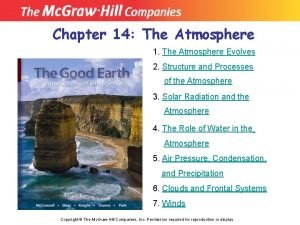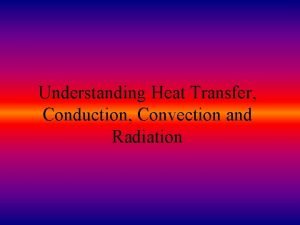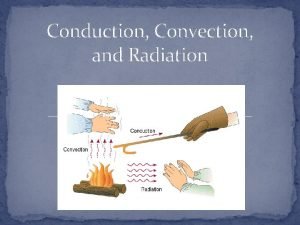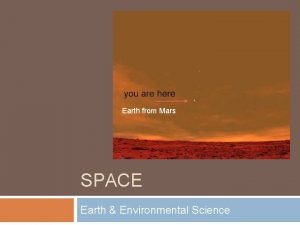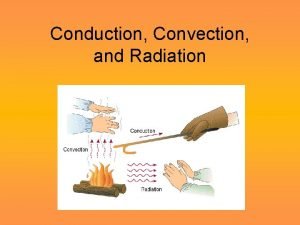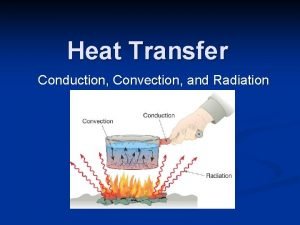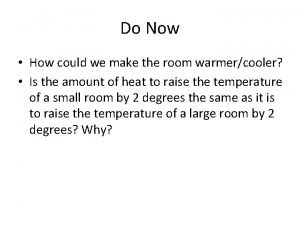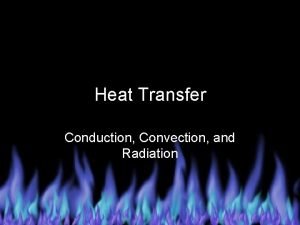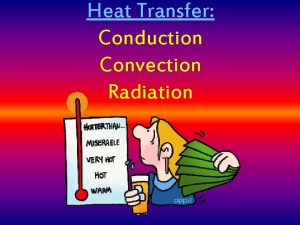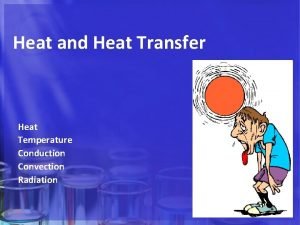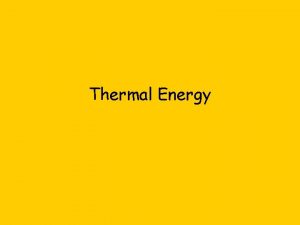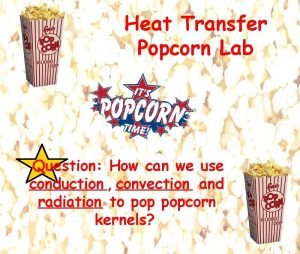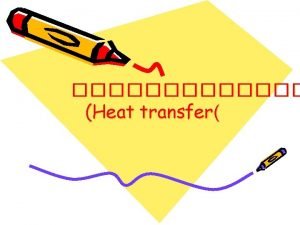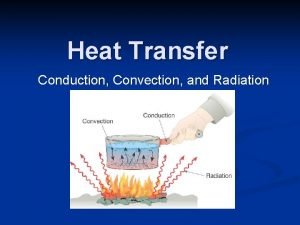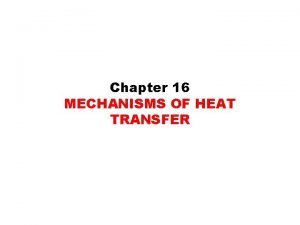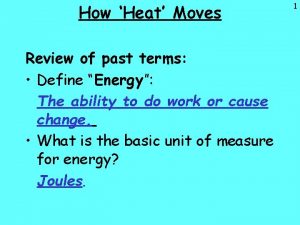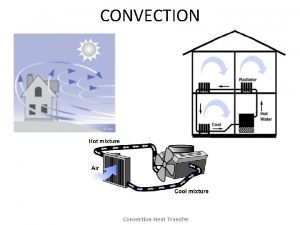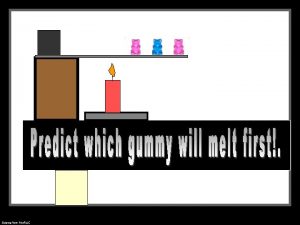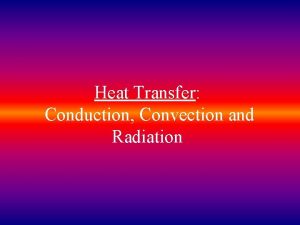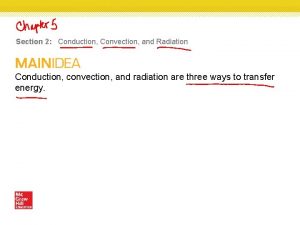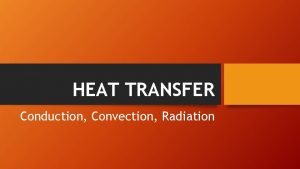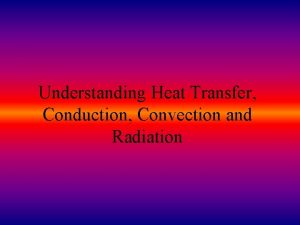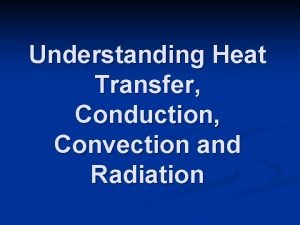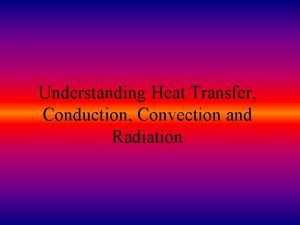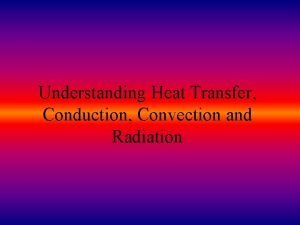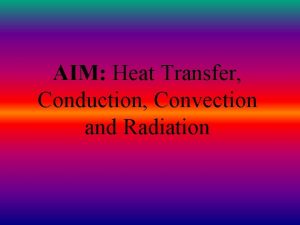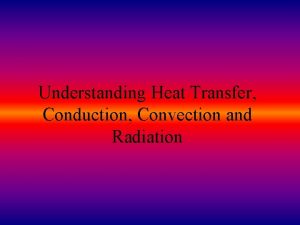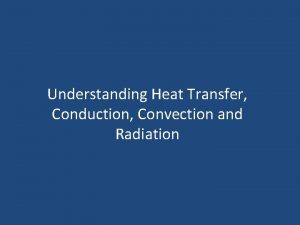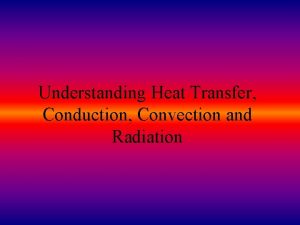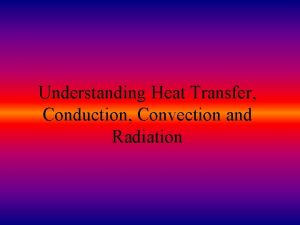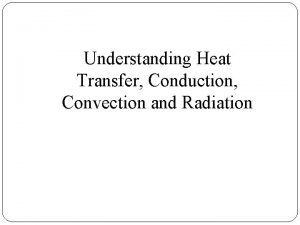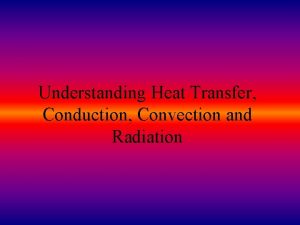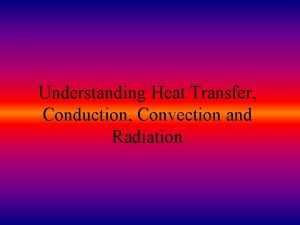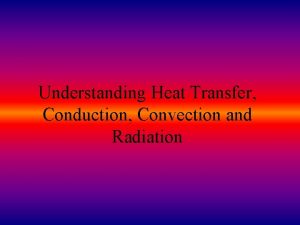Heat Transfer Conduction Convection and Radiation Heat Transfer























- Slides: 23

Heat Transfer…. . Conduction, Convection and Radiation

Heat Transfer • Heat always moves from a ____ place to a cooler place. • Hot objects in a cooler room will _____ to room temperature. • Cold objects in a warmer room will _____to room temperature.

Heat Transfer • If a cup of coffee and a red popsicle were left on the table in this room what would happen to them? Why? • The cup of coffee will cool until it reaches room temperature. The popsicle will melt and then the liquid will warm to room temperature.

Heat Transfer Methods • Heat transfers in three ways: o. Conduction o. Convection o. Radiation

Conduction When you heat a metal strip at one end, the heat travels to the other end. As you heat the metal, the particles vibrate, these vibrations make the adjacent particles vibrate, and so on, the vibrations are passed along the metal and so is the heat. We call this? Conduction

Metals are different The outer e______ lectrons of metal atoms drift, and are free to move. When the metal is heated, this ‘sea of inetic electrons’ gain k_____ energy and transfer it throughout the metal. Insulators, such as w___ ood and p____, lastic do not have this ‘sea of electrons’ which is why they do not conduct heat as well as metals.

Why does metal feel colder than wood, if they are both at the same temperature? Metal is a conductor, wood is an insulator. Your hands transfer the heat away easier into the metal. So the wood feels warmer than the metal.

Convection What happens to the particles in a liquid or a gas when you heat them? The particles spread out and become less dense.

Fluid movement Cooler, more d____, ense fluids sink through w_____, armer less dense fluids. In effect, warmer liquids and gases r___ ise up. Cooler liquids and gases s___. ink

Liquid/Gas movement

Sea breeze, Land breeze

Why is it windy at the seaside?

The third method of heat transfer How does heat energy get from the Sun to the Earth? ? There are no particles between the Sun and the Earth so it CANNOT travel by conduction or by convection. RADIATION


Infrared

Radiation travels in straight lines True/False Radiation can travel through a vacuum True/False Radiation requires particles to travel True/False Radiation travels at the speed of light True/False

Convection questions Why does hot air rise and cold air sink? Cool air is more dense than warm air, so the cool air ‘falls through’ the warm air. .

Radiation questions Why are houses painted white in hot countries? White reflects heat radiation and keeps the house cooler. Why are shiny foil blankets wrapped around marathon runners at the end of a race? The shiny metal reflects the heat radiation from the runner back in, this stops the runner getting cold.

1. Which of the following is not a method of heat transfer? A. Radiation B. Insulation C. Conduction D. Convection

2. In which of the following are the particles closest together? A. Solid B. Liquid C. Gas D. Fluid

3. How does heat energy reach the Earth from the Sun? A. Radiation B. Conduction C. Convection D. Insulation

4. Which is the best surface for reflecting heat radiation? A. Shiny white B. Dull white C. Shiny black D. Dull black

5. What speed does radiation travel? A. Speed of sound B. Faster than the speed of light C. 343 m/s D. Speed of light
 What is heat transfer conduction convection and radiation
What is heat transfer conduction convection and radiation Example of radiation
Example of radiation Does heat travel in a straight line
Does heat travel in a straight line Conduction of heat
Conduction of heat How does heat energy flow
How does heat energy flow Venn diagram states of matter
Venn diagram states of matter Venn diagram of conduction, convection and radiation
Venn diagram of conduction, convection and radiation Whats conduction convection and radiation
Whats conduction convection and radiation Whats conduction convection and radiation
Whats conduction convection and radiation Convection conduction radiation
Convection conduction radiation What is the picture about
What is the picture about How are conduction convection and radiation alike
How are conduction convection and radiation alike Method of heat transfer
Method of heat transfer Whats conduction convection and radiation
Whats conduction convection and radiation Radiation heat transfer examples
Radiation heat transfer examples Temperature, conduction, convection, radiation. *
Temperature, conduction, convection, radiation. * Bellringer conduction convection or radiation
Bellringer conduction convection or radiation We transfer
We transfer Transfer heat
Transfer heat Conduction convection radiation examples
Conduction convection radiation examples Temperature conduction convection radiation
Temperature conduction convection radiation Mechanisms of heat transfer
Mechanisms of heat transfer Conduction and convection venn diagram
Conduction and convection venn diagram Convection (heat transfer)
Convection (heat transfer)

